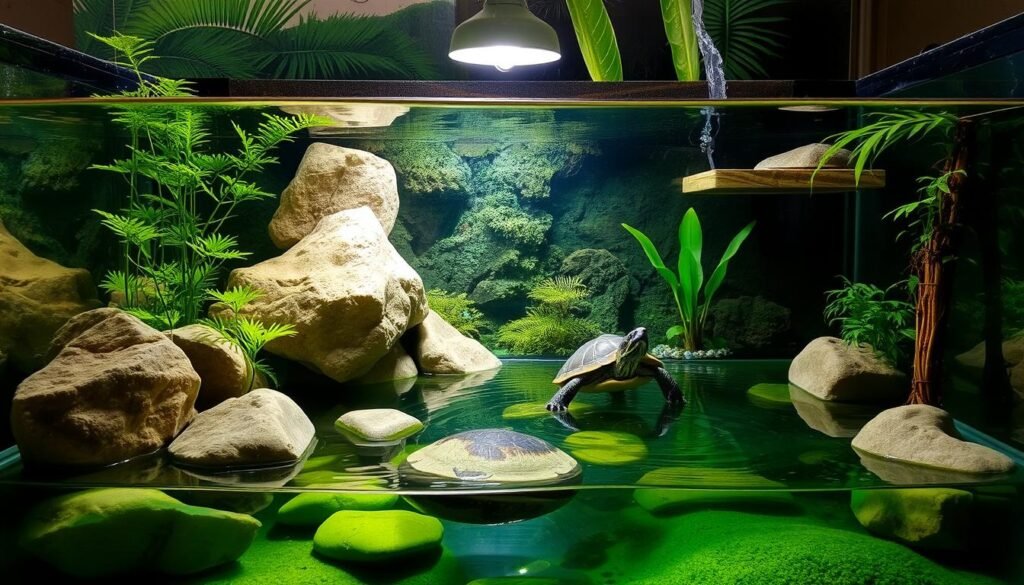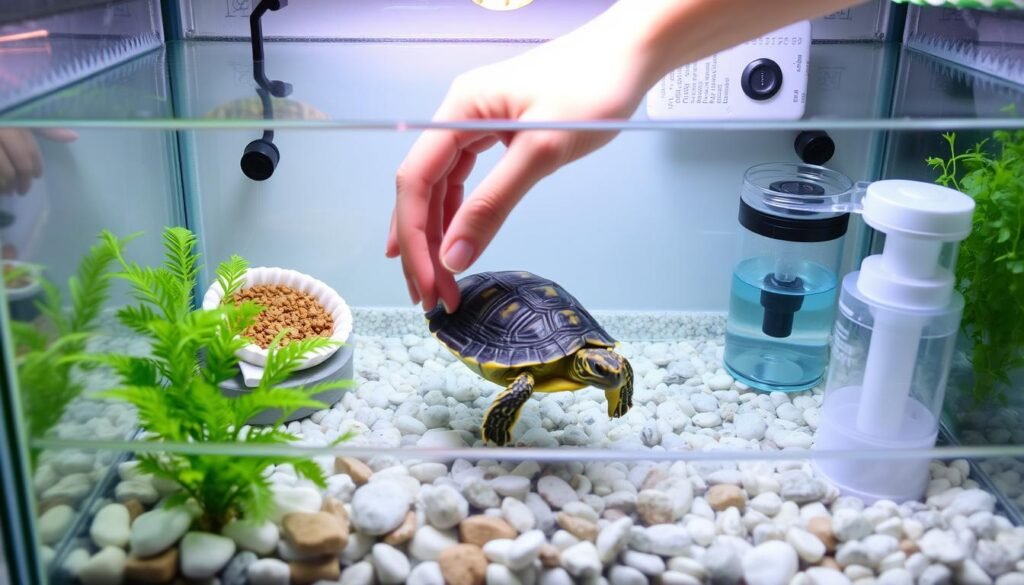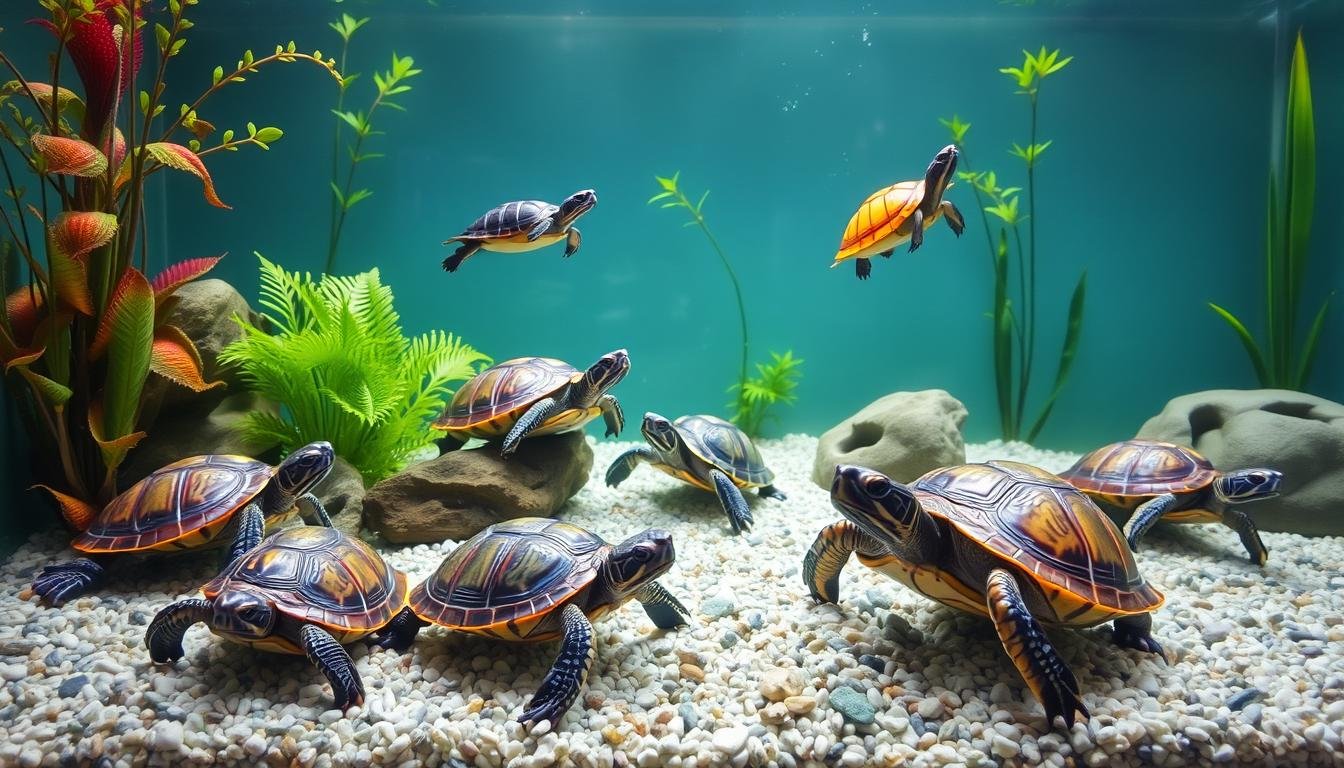Turtles have a special place in the hearts of reptile lovers. They are known for their unique personalities and long lives. These fascinating creatures make great companions for those who love reptiles and want to learn about aquatic turtle care.
Red-eared sliders are the top choice for pet turtles in the U.S. They appeal to both new and seasoned turtle keepers. Each turtle species needs its own care, including the right habitat, diet, and environment, to stay healthy and happy.
Before getting a turtle, it’s important to know they are not just pets. They need a lot of thought about their home, food, and long-term care. Adult turtles can grow up to 12 inches and live 20 to 40+ years with the right care.
Choosing the right turtle means doing your homework. You need to know about their needs, housing, and care. This knowledge helps create a great home for your turtle.
It’s key to understand the commitment needed for turtle care. They need clean water, UV light, and the right food. Turtles need consistent care to thrive in your home.
Understanding Pet Turtles: Types and Basic Information
Exploring the world of pet turtles is fascinating. It shows a wide range of turtle species and their special traits. Reptile lovers have many choices when picking these amazing creatures as pets.
Difference Between Turtles and Tortoises
Many people confuse turtles and tortoises, but they are different. Turtles live in water or near it. Tortoises, on the other hand, live on land.
- Turtles: Swim and live near water sources
- Tortoises: Exclusively land-based reptiles
- Diet varies between water and land species
Common Pet Turtle Species
Some small turtle species are great for beginners. Red-eared sliders, map turtles, and musk turtles are favorites. They are small and easy to care for.
Lifespan and Size Considerations
Knowing about turtle species means understanding their size and how long they live. Most pet turtles are 3.5 to 12 inches long. They can live 20 to 60+ years with the right care.
- Turtle size range: 3.5-12 inches
- Turtle lifespan: 20-60+ years
- Tortoises can grow 4 inches to 6 feet
- Tortoise lifespan: 25-100+ years
Before getting a turtle, it’s important to research the species. This helps find the right match for your home and lifestyle.
What Makes a Turtle Easy to Care for
Not all turtles are the same when it comes to care. Some are easier to look after than others. Knowing what makes a turtle easy to care for helps owners choose the right pet.
Several important factors affect a turtle’s care needs:
- Size and growth
- Diet flexibility
- Habitat complexity
- Activity level
- Waste production
Beginner-friendly turtles usually have a few traits in common. They are small, have flexible diets, and need simple habitats. For example, Mississippi Map Turtles and Razorback Musk Turtles are good for beginners.
Turtles can live for 20 to 40 years if cared for well. This means owners must be ready for a long commitment. Tanks start at 30 gallons for small species, and bigger tanks are needed for larger ones or more turtles.
It’s important to know each species’ specific needs. Things like basking spots, water temperature, and filters are key to a turtle’s happiness.
Top Easy to Care for Turtles for Beginners
Choosing the right turtle is key for new reptile owners. Not all turtles are the same when it comes to care. Some species are perfect for beginners starting their turtle journey.
Understanding a turtle’s unique traits and care needs is important. The following species are great for beginners. They are easy to care for and fit well in home environments.
Mississippi Map Turtles
Map turtles are great for beginners. They grow 5-8 inches long and love to swim. They also enjoy basking and need a habitat with both water and land.
- Great swimmers with unique shell patterns
- Moderate maintenance requirements
- Enjoy basking under proper lighting
Razorback Musk Turtles
Musk turtles are small pets, growing up to 6 inches. They produce less waste and are less active. This makes them perfect for beginners who want a low-energy pet.
- Compact size (under 6 inches)
- Low-maintenance habitat needs
- Minimal waste production
Eastern Box Turtles
Box turtles are a great choice for those who prefer a land-based pet. They don’t need complex water systems. This makes them ideal for owners who like terrestrial turtles.
- Primarily land-based habitat
- No complex water setup required
- Interesting terrestrial behaviors
When picking your first turtle, think about habitat needs, size, and how much time you can dedicate to care. Each species has its own special qualities. They can be the best fit for different beginners.
Essential Turtle Housing Requirements

Creating the right enclosure is key for your pet turtle’s health and happiness. The setup of the turtle tank depends on the species you choose. Each species has its own housing needs.
- Water depth should be 1.5 to 2 times the turtle’s shell length
- Allocate 10 gallons of water per inch of turtle shell
- Ensure 15-25% of the tank surface is a dry basking area
- Provide appropriate filtration for waste management
Aquatic turtles need special enclosures that mix water and land. A 20-gallon tank is a good start, but bigger turtles might need 55 or 75-gallon tanks. Semi-aquatic turtles need about 50% water, while fully aquatic ones need more.
For smaller turtles, indoor aquariums are great. But bigger turtles might need outdoor ponds. Make sure the enclosure is safe to prevent escapes and protect your turtle from predators.
The habitat should feel like their natural home. Use soil, sand, or rocks as substrates. Keeping the right temperature and using UV lighting is also vital for your turtle’s health.
Setting Up the Perfect Turtle Tank
Creating a great home for your turtle needs careful planning. The right tank setup is key for your turtle’s health and happiness. Let’s look at the important parts of setting up the perfect turtle environment.
Tank Size Guidelines
Choosing the right tank size is very important. The rule is to give 10 gallons of water for every inch of your turtle’s shell. For example, a 40 gallon tank is perfect for medium-sized turtles, giving them lots of room to swim and explore.
- Baby turtles need at least a 10-gallon aquarium
- Adult turtles require larger tanks, typically 40 gallons or more
- Consider the turtle’s adult size when selecting tank dimensions
Water Requirements
Water quality is very important in a turtle tank. Aquatic turtles need deep water to swim, while semi-aquatic species need both water and land areas. Keep the water temperature steady and use a thermometer to check it.
Filtration Systems
A good water filtration system is vital for a healthy turtle habitat. Even if your tank is smaller, choose a filtration system for at least a 75-gallon tank. This ensures waste is removed well and keeps the water clean.
- Use a strong canister water filtration system
- Clean the filter every 2-3 weeks
- Perform complete water changes every 1-2 weeks
- Use water conditioner to eliminate chlorine
Setting up the tank right takes some effort, but it’s worth it for a happy, healthy turtle.
Lighting and Temperature Needs
Turtle care is all about the right lighting. Turtles see UVA light that we can’t, helping them find food, mates, and rivals. Good uv lighting is key for their health and natural rhythms.
Knowing about uv lighting is vital for turtle owners. Turtles need specific light to stay healthy:
- UVB light helps make vitamin D3
- It’s needed for calcium absorption
- It helps with their daily and seasonal cycles
Choosing the right heat lamp is important for a good turtle home. Fluorescent UVB tubes are best because they cover a lot of area and last long. These lights mimic natural sunlight, giving heat and the UV spectrum turtles need.
Keeping the right temperature is also key. Most semi-aquatic turtles like it between 85-95°F in their basking spots. Infrared heat helps them warm up, which is good for vitamin D3 production. Try to give them 8-10 hours of light a day, like natural daylight.
Bad lighting can harm turtles. Not enough uv light can cause serious health problems. Talking to a turtle expert can help you find the best lighting for your turtle.
Creating the Ideal Basking Area
Creating a perfect basking area is key for your turtle’s health. Turtles need a special spot to get out of the water and control their body heat. A well-made basking area helps them behave naturally and stay healthy.
Basking Platforms Design
When setting up a basking area, remember these important points:
- Choose a sturdy platform that supports the turtle’s full body weight
- Ensure the bask zone is large enough for comfortable movement
- Use materials like smooth stone or wood for efficient thermoregulation
- Create a gentle ramp for easy water-to-land access
Heat Lamp and UVB Lighting Essentials
Proper lighting is vital for your turtle’s health. A heat lamp keeps them warm, and UVB lighting helps with vitamin D3 production. Here are some tips for your basking area:
- Position the heat lamp to create a warm spot between 85-95°F
- Use UVB lighting to prevent metabolic bone disease
- Avoid blocking UVB rays with glass or plastic barriers
- Replace UVB bulbs every 6-12 months for optimal effectiveness
By designing your turtle’s basking area with the right platforms and lighting, you’ll make a cozy space. It will be like their natural habitat and help them stay healthy.
Proper Diet and Feeding Schedule
Feeding your turtle right is key for its health and long life. Different turtles need different foods, but most eat a mix of protein and plants.
Here are some important feeding tips:
- Juvenile turtles need to eat more often (1-2 times daily)
- Adult turtles can eat every other day
- Feed an amount that fits inside the turtle’s head, excluding the neck
Good turtle food includes commercial pellets and fresh foods. Some top choices are:
- Omega One Aquatic Turtle Sticks
- Mazuri Aquatic Turtle Pellets
- Reptomin Sticks
Turtles like to eat in water. Always take out uneaten food in 10-15 minutes to keep the water clean. Add organic romaine lettuce and cuttlebone for extra nutrition.
Important tips for a healthy turtle diet include avoiding bad foods like iceberg lettuce, spinach, and red fish. Box turtles need 50% plants and 50% animal foods in their diet.
Water Quality Management
Keeping your turtle’s water clean is vital for their health. Aquatic turtles are very sensitive to water. So, it’s important to check and clean the water often. Bad water can cause serious problems like shell rot and breathing infections.
To keep your turtle’s home safe, you need to manage the water well. This means changing the water often and testing it regularly. These steps help keep your pet healthy.
Testing Water Parameters
Testing several key water factors is essential:
- Ammonia levels
- Nitrite and nitrate concentrations
- pH balance
- Water temperature
Use Tetra EasyStrips 6-in-1 to check these important water conditions. Testing the water every 1-2 weeks is important to avoid health problems.
Cleaning Schedule and Techniques
Here’s how to do water changes right:
- Change 4-10% of tank water weekly
- Remove uneaten food quickly
- Use a suction hose for substrate cleaning
- Clean tank walls to stop algae
Get a good filter like the Zoo Med Turtle Clean 318. It helps keep the water clean between changes. Water conditioners can also remove harmful chemicals from tap water.
Signs of Poor Water Quality
Look out for these signs that the water needs changing:
- Visible murkiness
- Foul odor
- Excessive debris
- Turtle showing signs of stress
Staying on top of water management is critical. Regular care stops health issues and keeps your turtle’s home thriving.
Health Monitoring and Common Issues
Keeping your turtle healthy means watching them closely and acting fast. Turtles can face many health issues that need quick care from a vet.
Many health problems in turtles come from their environment and food. Look out for signs that your turtle might be sick:
- Metabolic bone disease (shell deformities)
- Respiratory infections
- Vitamin A deficiency
- Shell infections
- Parasitic conditions
Metabolic bone disease is a big worry for turtle owners. It can make shells soft and bones brittle. This happens when turtles don’t get enough UVB light or eat too little calcium. Signs include soft shells, weak bones, and slow growth.
Respiratory infections are another big health issue. Turtles might show signs like:
- Excess mucus discharge
- Lethargy
- Reduced appetite
- Wheezing
- Open-mouth breathing
It’s important to take your turtle to the vet regularly. A reptile expert can check your turtle, suggest better food, and create a treatment plan for any issues.
Safe Handling Practices
Handling turtles needs careful attention and specific techniques. This ensures safety for both humans and turtles. Knowing the right way to handle them can greatly improve your experience with pet turtles.
Here are some key guidelines for handling turtles:
- Always support the turtle’s entire body with both hands
- Avoid sudden movements that might startle the animal
- Keep hands away from the turtle’s head to prevent bites
- Never pick up a turtle by its tail or limbs
Understanding turtles’ unique traits is the first step in turtle safety. Some have sharp claws or stress easily. Move slowly and gently to ensure a positive interaction. Always wash your hands before and after handling turtles to avoid disease.
Here are more precautions for handling turtles:
- Wash your hands with antibacterial soap before touching the turtle
- Use clean, dry hands to minimize stress to the animal
- Wear gloves if recommended for specific turtle species
- Keep handling sessions short and calm
Children should always be supervised when handling turtles. Adult guidance is key for both the child’s safety and the turtle’s well-being. Remember, each turtle has its own personality and comfort level with handling.
Daily and Weekly Care Routine

Keeping a regular turtle care routine is key for your pet’s well-being. A good daily and weekly plan ensures your turtle stays healthy and happy. The main part of daily care is feeding, cleaning, and watching your turtle.
Your daily turtle care routine should focus on several critical aspects:
- Feeding your turtle at consistent times
- Checking water temperature and quality
- Removing uneaten food to prevent water contamination
- Observing your turtle’s behavior and overall health
For weekly turtle care, consider these essential tasks:
- Perform a partial water change (about 20-25% of tank volume)
- Clean and inspect the filtration system
- Check and replace UVB lighting if needed
- Thoroughly inspect the habitat for any signs of wear or damage
Temperature management is critical in your turtle care routine. Keep daytime temperatures between 82-86°F and nighttime temperatures around 74-80°F. Make sure your turtle gets 10-12 hours of UVB light daily for calcium absorption and health.
Young turtles need to eat every day, while adults can eat every other day. Always give a balanced diet with 50% fresh leafy greens and occasional calcium supplements for their nutrition.
Essential Supplies Checklist
Setting up the perfect home for your pet turtle needs careful planning. You must choose the right turtle supplies and pet turtle essentials. This ensures your turtle stays healthy and happy.
- Aquarium or Enclosure
- 40-55 gallon tank for younger turtles
- Lifegard Aquatics crystal aquarium recommended
- 200-gallon Waterland tub for larger species
- Habitat Accessories
- Zoo Med floating log hideout
- Penn-Plax turtle topper basking platform
- Flat stone for optimal basking area
- Temperature and Lighting
- Zoo Med aquatic turtle UVB and heat lighting kit
- Aqueon Pro aquarium heater
- HDE LCD digital aquarium thermometer
Keeping the water clean is key for your turtle’s health. Use a high-quality canister filter to keep the water fresh. Also, change 30% of the water every 1-2 weeks to avoid toxins.
- Water Management Supplies
- Tetrafauna ReptoFilter
- Water conditioner
- Water test kit
- Cleaning Supplies
- Hepper Advanced Bio-Enzyme Spray
- Soft cleaning brushes
Keep the water temperature between 70-82°F and the basking area at 95-104°F. Also, provide 10-14 hours of light, depending on the season. This helps keep your turtle healthy and happy.
Conclusion
Caring for pet turtles needs dedication and a good understanding of these amazing reptiles. It’s not just about giving them a place to live. You must also pay close attention to their special needs for food and environment. By choosing the right turtle and being ready for a long-term commitment, you can make a great home for your turtle.
It’s important to know what your turtle needs, whether it’s for water or land. Keeping the right temperature, feeding them the right food, and keeping their home clean are all key. Remember, turtles can live 20-40 years, so they are a big responsibility.
If you’re thinking about getting a turtle, do your homework first. You’ll need to learn about keeping the water right and feeding them well. Taking care of a turtle requires patience and always learning more. With the right care, you’ll have a wonderful bond with your turtle.
At the end of the day, taking care of a turtle is about making a safe and interesting place for them. With the right knowledge and commitment, your turtle can be a wonderful, long-lasting friend. They will bring joy and wonder into your life.
FAQ
What is the difference between turtles and tortoises?
Turtles live in water or near it, while tortoises live on land. Turtles have flat shells and webbed feet for swimming. Tortoises have dome-shaped shells and strong feet for walking.
How long do pet turtles typically live?
Pet turtles can live a long time, up to 60 years or more. Some can even live up to 100 years with good care. They are a big commitment for pet owners.
What are the easiest turtle species for beginners?
Beginners should consider Mississippi Map Turtles, Razorback Musk Turtles, and Eastern Box Turtles. These turtles are smaller and easier to care for.
How much space does a pet turtle need?
You need 10 gallons of water for every inch of turtle shell. For example, a 5-inch turtle needs a 50-gallon tank. It should have good filtration, a basking area, and temperature control.
What do pet turtles eat?
Pet turtles eat a mix of foods. They need turtle pellets, fresh veggies, and animal proteins like worms and shrimp. Young turtles eat every day, while adults eat every 2-3 days.
Do turtles need special lighting?
Yes, turtles need UVB lighting for vitamin D. Place a UVB light over their basking area. Keep the basking spot at 85-95°F for most turtles.
How often should I clean my turtle’s tank?
Change the water weekly and clean the filter every 2-3 weeks. Clean the tank completely every 1-2 weeks. Remove uneaten food and test the water quality regularly.
Can I handle my pet turtle?
You can handle turtles gently. Always support their body and avoid turning them upside down. Wash your hands before and after handling to prevent salmonella.
What are the most important supplies for a pet turtle?
You’ll need a big tank, UVB light, basking light, water heater, and filter. Also, a basking dock, substrate, water conditioner, and test kit. Don’t forget a thermometer and the right food.
Do turtles recognize their owners?
Turtles can recognize their owners. They have good senses, including sight and hearing. Over time, they may show they know their owners and feel comfortable around them.













